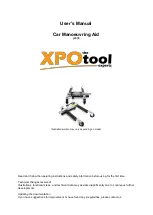
12
CAT IV:
Overvoltage category IV: Devices such as electricity
meters, overcurrent circuit breakers and ripple-control units,
which are intended for use at or near the infeed into the
electrical installation of buildings, and specifically from the
main distribution to the supply system.
CAT III:
Overvoltage category III: Equipment in fixed
installations and for applications where specific requirements
with regard to the reliability and availability of equipment
have to be met, e.g. circuit-breakers in fixed installations and
devices used in industrial applications which are permanently
connected to the fixed installation.
Insertion of batteries
(see Fig. E)
1
The device is ready for use immediately once the
batteries have been inserted. It does not have a
separate ON/OFF switch and is therefore always active.
As from a measuring voltage of 50 V, the device
operates in emergency mode even without batteries.
!
Open the battery compartment and insert batteries according
to the symbols. Be sure to pay attention to polarity.
CAT II:
Overvoltage category II: Single-phase consumers that
are connected to standard sockets, e.g. household appliances,
portable tools.
Symbols
Fig. C:
Danger area warning
Fig. D:
Protection class II: The test device has reinforced or
double insulation.
Fig. B:
Hazardous electrical voltage warning: Unprotected live
components inside the device housing may pose a risk of electric
shock.
Safety instructions
Dealing with electromagnetic radiation
• The measuring device complies with electromagnetic
compatibility regulations and limits in accordance with the
EMC Directive 2014/30/EU which is covered by the Radio
Equipment Directive 2014/53/EU.
• Local operating restrictions – for example, in hospitals, aircraft,
petrol stations or in the vicinity of people with pacemakers –
may apply. Electronic devices can potentially cause hazards or
interference or be subject to hazards or interference.
EN
Summary of Contents for AC-tiveMaster
Page 52: ...52...













































